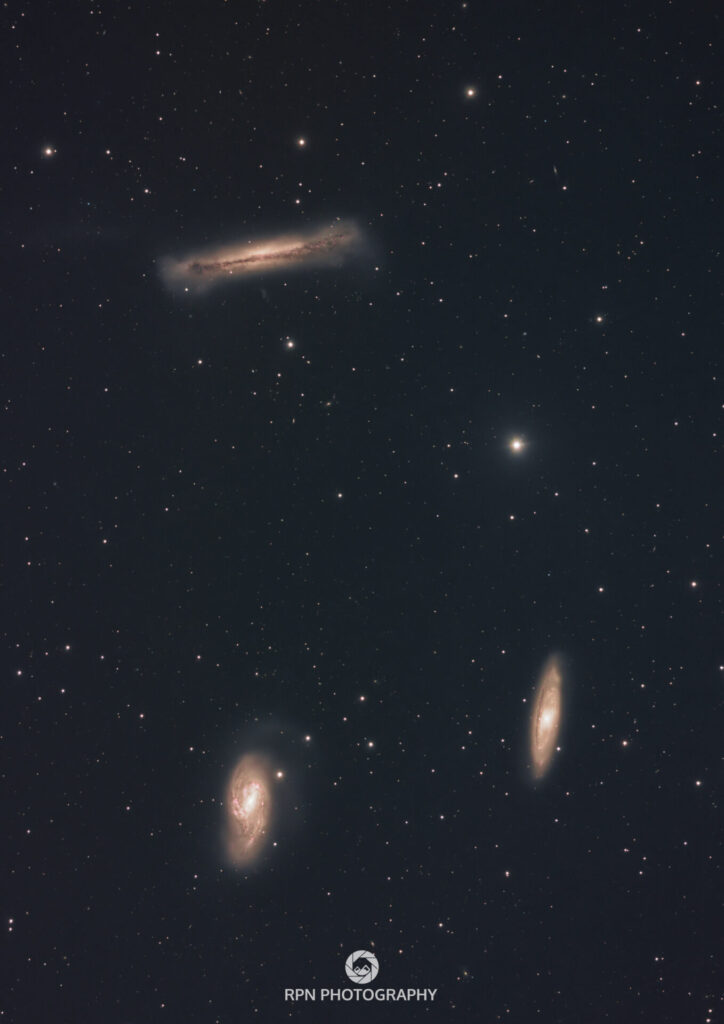The skies have cleared, and The BV’s astrophotographer Rob Nolan is celebrating the start of galaxy season with a special trio
Slightly more favourable conditions throughout April meant at least a few clear nights to see the galaxies far far away – especially now that we have officially entered ‘galaxy season’. With a greater number of galaxies visible in the night sky than at any other time of year, many amateur astronomers take advantage of the opportunity to observe and photograph these amazing objects.
I’m a bit late into galaxy season, which starts in March, but as we all know, the weather was not great. So to kick things off, I thought I’d go for a three in one!
The Leo Triplet, also known as the M66 Group, consists of a small group of galaxies a mere 35 million light years away, in the constellation Leo. In this photograph, clearly visible are M65 (bottom right), M66 (bottom left) and NGC 3628 (top). M65 and M66 are spiral galaxies, while M65 appears to not have much gas and dust; its high ratio of old stars to young suggests that there is little new star formation going on.
M66 appears rather more interesting, with bright star clusters along its sweeping spiral arms.
NGC 3628, also known as the Hamburger Galaxy, appears as though it may be a barred spiral galaxy with the bar seen end-on edge from Earth, making it a most conspicuous galaxy to observe.
Since there’ll no doubt be more galaxies coming, it seems the perfect time for a quick explainer on the three basic types. Spiral galaxies, such as our Milky Way, are rich in gas and dust, great for star creation.
Irregular galaxies have similar ingredients and potential, but are usually smaller and don’t form a discernible shape. Finally, we have elliptical galaxies – these vary in size dramatically from very small to mind-bogglingly huge! Not as pretty as spiral galaxies, they take on a rather uninspiring oval shape. Most stars in these galaxies appear red, due to being older, with very few new stars being created due to the lack of gas and dust.
This image of the Leo Triplet was captured with my 1000mm Maksutov Newtonian Telescope and the ZWO ASI2600MM Pro Astro camera with Broadband filters and is about four hours of data.
The night sky, May 2023 – Rob’s guide for your stargazing this month:
Our local neighbours – that’s Venus and Mars for anyone wondering – grace our western skies this month.
The southern skies are currently dominated by the immense, stunning orange star Arcturus. Look to the lower right of Arcturus this month and you’ll find a couple of bright blue stars, Spica and Regulus. Near to Arcturus in the region to its left, you might also make out the faint stars making up the two giant constellations Ophiuchus and Hercules.
But this month’s constellation has to be Ursa Major, the Great Bear, which is an international favourite. You’ll no doubt know its seven brightest stars as the Plough here in the UK. This constellation is always on show in the northern hemisphere, so it tends to be the first star formation stargazers become familiar with.
An interesting fact about this constellation is that the majority of the stars lie at the same distance away from Earth and appear to have been born around the same time. The constellation is also home to some binary stars that you can ‘split’ with the unaided eye.
Star dates for the diary
Particular events of interest this month include the annual Eta Aquarid Meteor shower on the 7th May in the very early hours, caused by small pieces of Halley’s Comet burning up in Earth’s atmosphere. Unfortunately though, due to the bright moon during the night, the unusually intense display will likely be washed out. It may still be worth trying to catch a glimpse though!
The rest of the notable events this month involve our Moon and its regular dance in and around the views of the inner planets.
On the night of the 13th and 14th May, just before dawn, observe the enchanting crescent Moon passing below Saturn.
On the 22nd May, Venus, the Evening Star, will appear above and to the left of the thin
crescent Moon.
In the twilight sky of the 23rd May, the crescent Moon and Venus appear to get very close, with the familiar stars Castor and Pollux just above. Mars also makes an appearance on set, looking left in the sky.
On the 24th May, Mars again makes an appearance below the crescent Moon, with stars Castor and Pollux and the planet Venus off to the right lower in the sky.
Until next time, clear skies!




